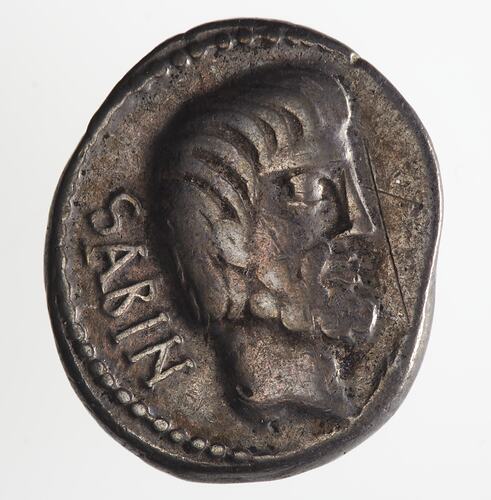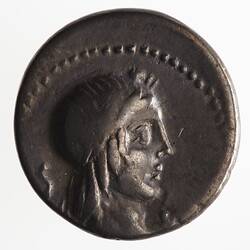Summary
Denarius, issued by Ancient Roman Republic, 89 BC
Moneyer: L.TITVRI L.F SABINVS (L. Titurius L. f. Sabinus)
Minted in Rome
Obverse Description
Bearded head of King Tatius facing right; behind, SABIN
Reverse Description
At centre, Tarpeia kneeling, arms raised; a Sabine soldier, shields raised on either side; above, star inside crescent; in exergue, L. TITVR[I]
Edge Description
Plain
Significance
The name of the moneyer, Sabinus, is referred to by the pictorial types of this coin but is unlikely to be a claim of Sabine origin of the man. When Rome was first settled the Sabine people were their neighbours. According to the legend, the Romans sought Sabine wives but were rejected by the Sabine people. In response to the rejection the Romans invited the Sabines to a festival and then abducted the Sabine women who attended. With their king, Titus Tatius (depicted on the obverse), the Sabines returned in force. The daughter of the governor of the Roman citadel, Tarpia, opened the gates after arranging to be given what the Sabine soldiers had on their arms. She was referring to golden bracelets, but they, feeling that their shields fulfilled the arrangements, crushed her (pictured on the reverse of the coin) and threw the body off a rock (afterwards known as the Tarpean Rock). The Romans fought back and soon looked like they would win. At that point the the Sabine women intervened declaring that they were happy with their new husbands and status in Roman society but if the battle continued either these husbands or their fathers and brothers would perish; neither of which they wanted. Peace was made and Tatius ruled jointly with Romulus and Remus. Later, the Tarpean Rock was the place from which murderers and trators were traditionally thrown.
More Information
-
Collection Names
-
Collecting Areas
-
Acquisition Information
Transfer from National Gallery of Victoria (NGV), 15 Mar 1976
-
Date Issued
89 BC
-
Issued By
-
Person Depicted
-
Mint
-
Person Depicted
-
Denomination
-
Material
Silver
-
Axis
06
-
Classification
-
Category
-
Discipline
-
Type of item
-
Dimensions
18 mm (Outside Diameter), 3.8 g (Weight)
-
Shape
Off round
-
References
Crawford 344/2c
[Book] Crawford, Michael H. 1974. Roman Republican Coinage., 352-356 Pages
[Catalogue] Pullin, Ruth. 2011. Nature Revealed: Eugene von Guerard.
-
Keywords








